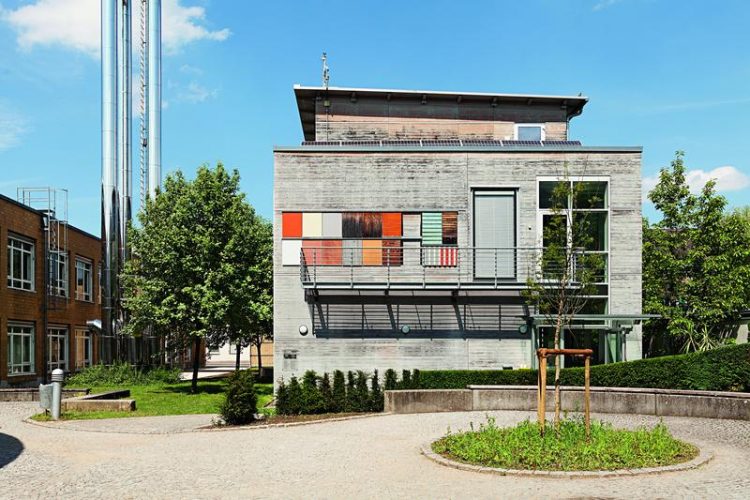Heating and cooling with environmental energy

The technical centre “Gebäude G” at the Biberach University of Applied Sciences. Different types of TABS are built-in here. The building is used for research and teaching. © Hochschule Biberach. Institut für Gebäude- und Energiesysteme, Stefan Sättele
In these concepts, the environmental heat sources, heating and cooling technology in the building and the comfort requirements of the users are matched as closely as possible with each other right from the beginning of the planning. This enables considerable energy efficiency.
Optimising thermo-active building systems and heat pumps
In contrast to the current assessment of the energy consumed in buildings, which is purely quantitative, low-exergy concepts also take qualitative aspects of the energy conversion into consideration. The large surfaces of the thermally active components mean that moderate temperature differences between the heating system and indoor temperature are sufficient to heat and cool buildings. The temperature changes that transform environmental heat into usable heat are also correspondingly low – providing ideal conditions for the efficient operation of heat pumps. The more the temperature level of the heat source corresponds to the use, the lower the exergy utilisation.
In addition to the requirements for optimised building services technology, the BINE Themeninfo brochure also focusses on the planning, regulation, operational management and control. The content is rounded off with a look at the experiences gained from three research and demonstration buildings where low-exergy concepts have been implemented and measured over several years of operation. The authors are Professor Roland Koenigsdorff from the Institute for Building and Energy Systems (IGE) at Biberach University of Applied Sciences and Dr Doreen Kalz from the Fraunhofer Institute for Solar Energy Systems. She coordinated the LowEx:Monitor research project, in which 25 non-residential buildings were evaluated and measured in detail based on a model.
You found all informations about the BINE Themeninfo brochure entitled “Efficiently heating & cooling non-residential buildings” here:
http://www.bine.info/en/press/press-releases/archive-press-releases/pressemittei…
Uwe Milles/Birgit Schneider
presse(at)bine.info
About BINE Information Service
Energy research for practical applications
The BINE Information Service reports on energy research topics, such as new materials, systems and components, as well as innovative concepts and methods. The knowledge gained is incorporated into the implementation of new technologies in practice, because first-rate information provides a basis for pioneering decisions, whether in the planning of energy-optimised buildings, increasing the efficiency of industrial processes, or integrating renewable energy sources into existing systems.
About FIZ Karlsruhe
FIZ Karlsruhe – Leibniz Institute for Information Infrastructure is a not-for-profit organization with the public mission to make sci-tech information from all over the world publicly available and to provide related services in order to support the national and international transfer of knowledge and the promotion of innovation.
Our business areas:
• STN International – the world’s leading online service for research and patent information in science and technology
• KnowEsis – innovative eScience solutions to support the process of research in all its stages, and throughout all scientific disciplines
• Databases and Information Services – Databases and science portals in mathematics, computer science, crystallography, chemistry, and energy technology
FIZ Karlsruhe is a member of the Leibniz Association (WGL) which consists of 87 German research and infrastructure institutions.
http://www.bine.info/en – BINE Informationsdienst
Media Contact
All latest news from the category: Architecture and Construction
Newest articles

“Nanostitches” enable lighter and tougher composite materials
In research that may lead to next-generation airplanes and spacecraft, MIT engineers used carbon nanotubes to prevent cracking in multilayered composites. To save on fuel and reduce aircraft emissions, engineers…

Trash to treasure
Researchers turn metal waste into catalyst for hydrogen. Scientists have found a way to transform metal waste into a highly efficient catalyst to make hydrogen from water, a discovery that…

Real-time detection of infectious disease viruses
… by searching for molecular fingerprinting. A research team consisting of Professor Kyoung-Duck Park and Taeyoung Moon and Huitae Joo, PhD candidates, from the Department of Physics at Pohang University…





















